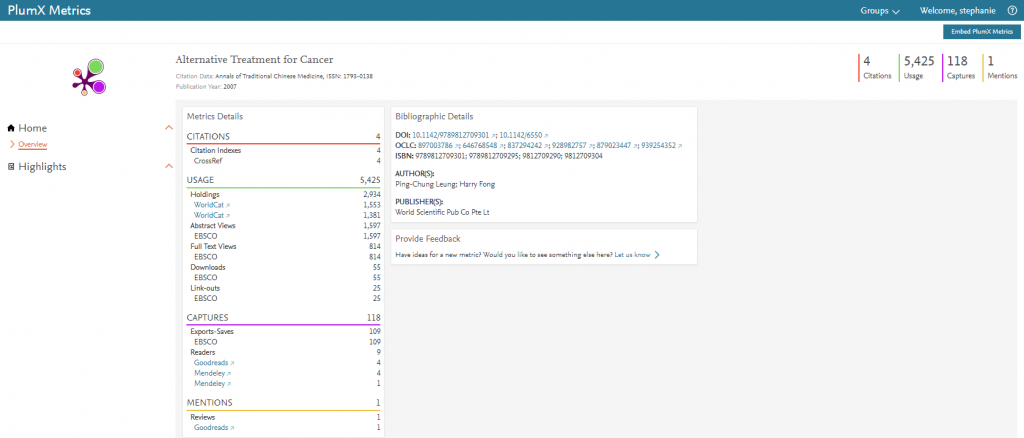
Research funders, third level institutions and prospective employers increasingly evaluate research outputs using measures which include quantative indicators such as bibliometrics. Bibliometrics look at publication profiles and citation analyses, which are important grant and career measures for individual researchers. There are various tools available to generate bibliometric analyses and which enable authors to optimise their own profile.
Why measure or track research impact?
Bibliometrics are measures of an author's influence or impact. Citation analysis is an area of bibliometrics research in which citations in scholarly articles are used to establish relationships between authors or articles.
Two commonly used bibliometrics are impact factor and h-index. See the link on the left of this page (white paper from Thomson Reuters) for more information about how these metrics are used. See the links on the Resources page for information on how to look up/calculate numerical values for these and other metrics.
SciVal is a benchmarking tool that uses Scopus data to allow you to visualize your research performance, benchmark relative to peer institutions, develop strategic partnerships, identify and analyze new, emerging research trends, and create uniquely tailored reports (https://www.elsevier.com/solutions/scival)
Create research groups from profiles of RCSI researchers as well as collaborators from other institutions, and use the benchmarking reports based on these groups to support funding applications or to inform strategic planning. Current and potential collaborators can be identified and research trends analysed to discover the activity and impact of institutions and individuals and current developments.
It is advisable to avoid using just one metric; instead a range of metrics will provide a fuller picture. Metrics are designed to complement and not replace peer review or expert opinion, so it is important to include them in your analysis also.
SciVal is made up of four modules: Overview, Benchmarking, Collaboration and Trends. It uses Scopus data for traditional publication and citation metrics and usage data from Scopus and ScienceDirect, global mass media, patents and funding awards to measure research visibility and socio-economic impact.
Altmetrics complement traditional bibliometrics by tracking the early impact of your research outputs. They uncover conversations occurring on twitter, blogs, websites, academic networks, reference management systems, and other social media forums. They can be an indicator of influence and data gathered can show how research may change practice. Altmetric.com and Plum Analytics are examples of organisations involved in this area. Scopus now includes altmetrics at article level, as do many individual journals and publishers.
Journal impact measures attempt to quantify the importance of a particular journal in its field, usually via a formula that takes into account the number of articles published per year and the number of citations to articles published in that journal. This page describes common journal impact metrics, as well as tools to use to find them.
Impact factor is a measure of the frequency with which the "average article" in a journal has been cited in a particular year or period.
Journal Citation Reports (JCR) ® is the only place where impact factors are reported. JCR® covers approximately 7,500 journal titles, which is only a small percentage of all journals in publication.
Limited to journals indexed in Web of Science (Web of Science Selection process). Journals not indexed in this database do not have an impact factor.
Science and social science are more likely to have impact factors than humanities journals. .
Learn more about Journal Citation Reports: http://clarivate.libguides.com/jcr / Video intro

EigenFactor is the ranking based on incoming citations for a journal with more weight given to citations from significant and larger journals.
1. Journal impact metrics do not assess the quality of individual articles, their importance, or usefulness! The quality and impact of the author's work may extend beyond the impact of a particular journal.
2. "To say that because a researcher is publishing in a certain journal, he or she is more influential or deserves more credit is not necessarily true. There are many other variables to consider." (Jim Testa, a researcher for ThomsonReuters Scientific in a 2008 interview)
3. Journal Impact Factor, Eigenfactor, and CiteScore cannot be used to compare journals from different subject fields.
4. Citation-based journal impact metrics are higher in disciplines in which rapid citation is the standard. Fields with a more durable literature, such as mathematics, have a much smaller fraction of short-term citations and hence lower journal impact factors.
5. Journal impact metrics can be manipulated (The Journal that could not stop citing itself ; Coercive Citation in Academic Publishing)
Altmetrics complement traditional bibliometrics by tracking the early impact of your research outputs. They uncover conversations occurring on twitter, blogs, websites, academic networks, reference management systems, and other social media forums. They can be an indicator of influence and data gathered can show how research may change practice. Altmetric.com and Plum Analytics are examples of organisations involved in this area. Scopus now includes altmetrics at article level, as do many individual journals and publishers.
Currency - Altmetrics can be gathered and calculated immediately, compared with traditional citations that accumulate slowly.
Diversity - Altmetrics capture data from a variety of sources, not just the traditional academic publishing setting, and thus may reflect the broader impact of research beyond the scholarly community. Additionally, altmetrics can be captured for research outputs beyond articles, like data sets, software, molecular structures, etc.
Many altmetrics are embedded in our databases. Look for links such as "Article Metrics" or "Metrics." For example, Scopus, EBSCOhost databases, EBSCO Discovery Service, ScienceDirect, ProQuest databases display PlumX metrics.

Sage, Wiley, Taylor & Francis, and Nature display Altmetric data. Altmetric collects relevant mentions from social media sites, newspapers, policy documents, blogs, Wikipedia, and many other sources.